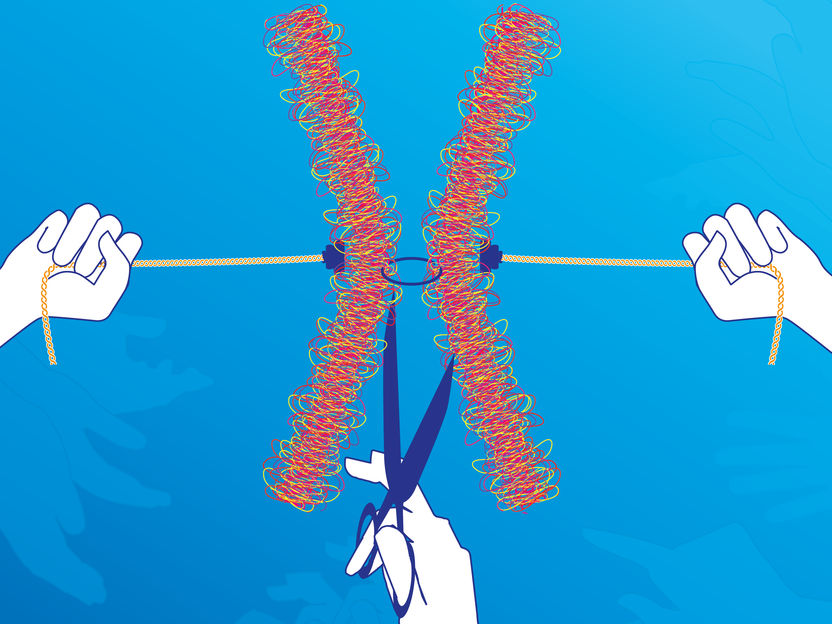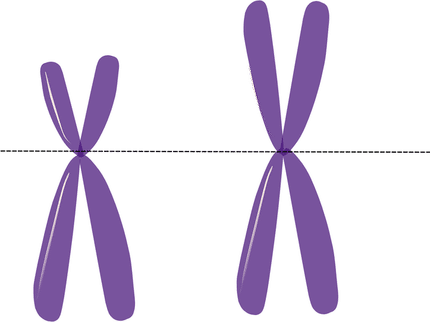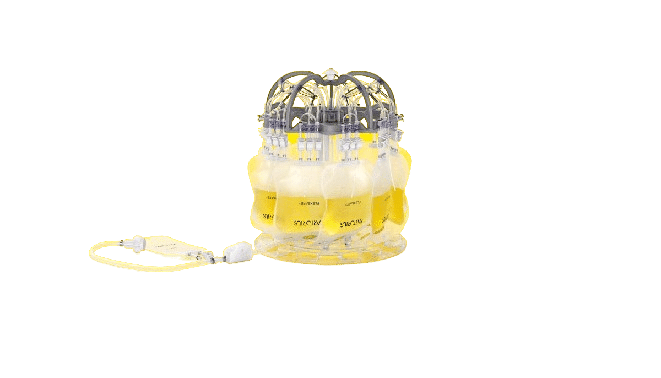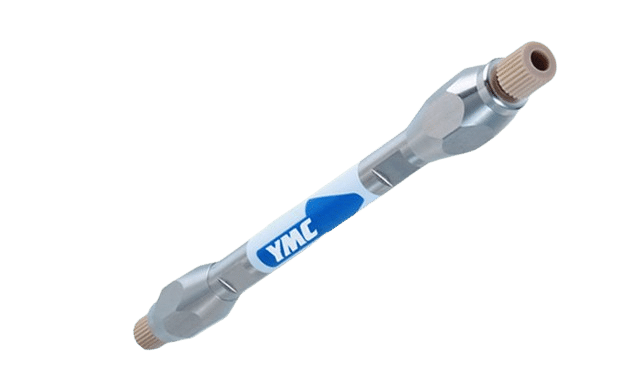With scissors and string
Chromosome segregation in meiosis
Once together, never apart – isn’t that how the saying goes? Not so in meiosis, the special type of cell division in which gametes, sperm and egg cells are formed. At the start of meiosis the ring-shaped protein complex, referred to as cohesin, is the string that ties the chromosome strands together. The chromosomes are where the blueprint for the body is stored. If each egg cell and each sperm is to come out of meiosis with only one set of chromosomes, these strings need to be cut up in a precise pattern. Scientists from the Max Planck Institute of biochemistry have demonstrated in baker’s yeast how a kinase enzyme, which is also present in the human body, controls the cleavage of the cohesin rings and coordinates it with the exit from meiosis and gamete formation. It is a mechanism, which could explain how chromosome segregation is regulated, or goes wrong, in human sperm and egg cells.

The Kinase-Enzyme Hrr25, pictured as a hand, coordinates and controls key steps in the second meiotic cell division, such as the cleavage of the chromosomes.
Monika Krause © MPI für Biochemistry
Why is it that children look like their parents? Most of the cells in our body are diploid, which means that they have two copies of each chromosome – one from the mother and one from the father. Only gametes, in other words egg and sperm cells, contain a single copy. So the cell has to halve its double set of chromosomes in order to be able to make haploid gametes. This happens in a special type of cell division called meiosis. However, meiosis is surprisingly complicated. Instead of just dividing up the maternal and paternal chromosomes between two daughter cells, the chromosomes are first duplicated so that they each consist of two strands, or chromatids. Duplicated paternal and maternal chromosomes then align and the chromosome arms are spliced together. This produces new chromosomes out of four chromatids held together by ring-shaped protein complexes, the cohesins, which act like strings. Two divisions of the nucleus are needed in order to split these chromosomes up into their chromatids again in processes referred to as the first and the second meiotic divisions. In the first division, the cohesin rings on the chromosome arms are cut up by the enzyme separase, which acts like a molecular pair of scissors. This results in X-shaped chromosomes consisting of two chromatids held together by cohesin rings only in their centre, known as the centromer. The second meiotic division is when the separase scissors ultimately cut the cohesin rings at the centromer. Four haploid gamete nuclei are produced, each of which contains one chromatid from each chromosome, in other words a blueprint for the body. If the egg is fertilized, the genetic material from the mother and the father combines and a new diploid chromosome set is produced, or to put it simply: a baby with daddy’s nose and mummy’s eyes.
The question is, how do the separase scissors know when and where the cohesin rings have to be cut? If cohesin rings are cut too early or in the wrong place, chromosome segregation mistakes occur that can lead to miscarriage or trisomy, such as Down’s syndrome.
Wolfgang Zachariae and his Research Group “Chromosome Biology” have already shown how the cohesin rings are marked for cutting. The kinase enzyme Hrr25 places a phosphate molecule at the point where the cohesin ring should be cut, and this tells the separase scissors: “Cut here!” That is how the cohesin rings are removed from the chromosome arms in the first division. The cohesin rings on the centromeres, however, are still safe from the scissors, as a phosphatase enzyme comes in and removes the phosphate marking. “So the decision as to whether or not a cohesin ring is actually cut depends on the winner of the kinase-phosphatase battle. In the first division the kinase wins on the chromosome arms, but then it loses against the phosphatase on the centromeres,” explains Zachariae. The Group’s latest work has now demonstrated how the kinase wins its fight against the phosphatase at the centromer in the second division. What happens here is that Hrr25 makes a cellular protein shredder cut off the phosphatase’s connection with the centromer. The phosphatase disappears from the centromer, and then Hrr25 is able to mark the cohesin for the separase scissors and the chromatids are cut apart. Besides separating the chromatids, the Hrr25 kinase also triggers the exit from meiosis and starts the formation of spores, which corresponds to gamete formation in yeast. “Hrr25 is thus a bit like the conductor of the second meiotic division,” says Zachariae.
This versatile kinase is also present in human cells. In future studies, the scientists aim to show whether or not Hrr25 controls the decisive stages in the second meiotic division in humans too. “Experiments in yeast give us significant hypotheses to work with about how chromosome segregation may be regulated in higher organisms,” says Wolfgang Zachariae. “These studies are expected to help find the causes of chromosome segregation mistakes in human eggs.
























































